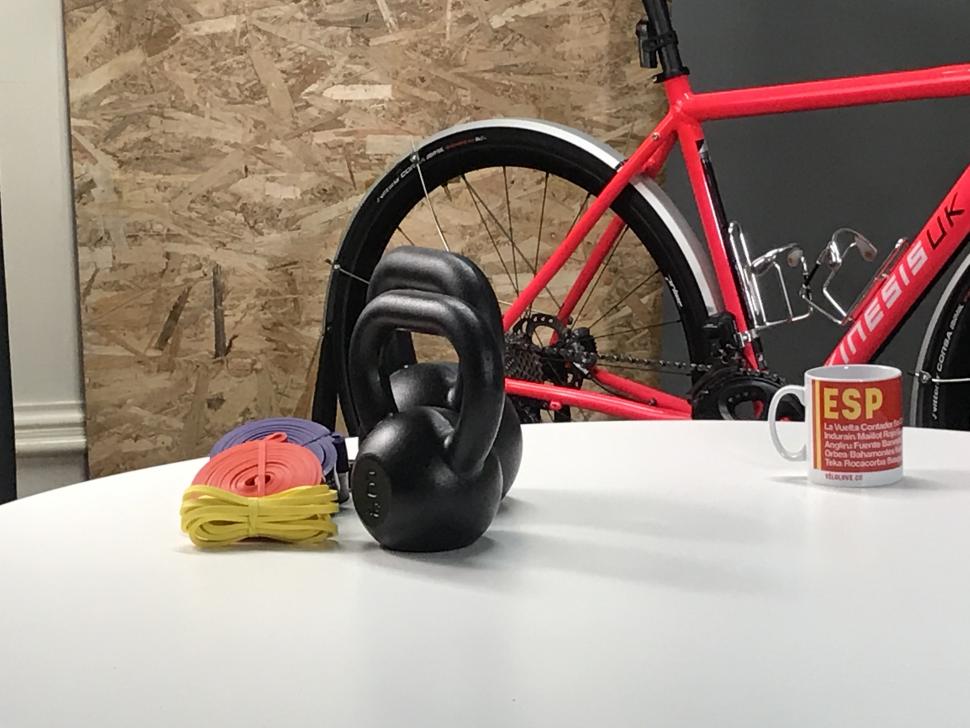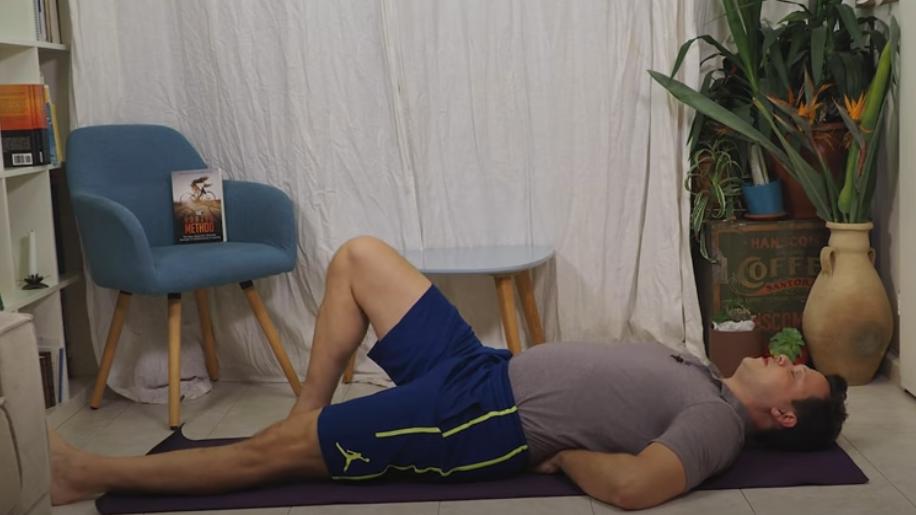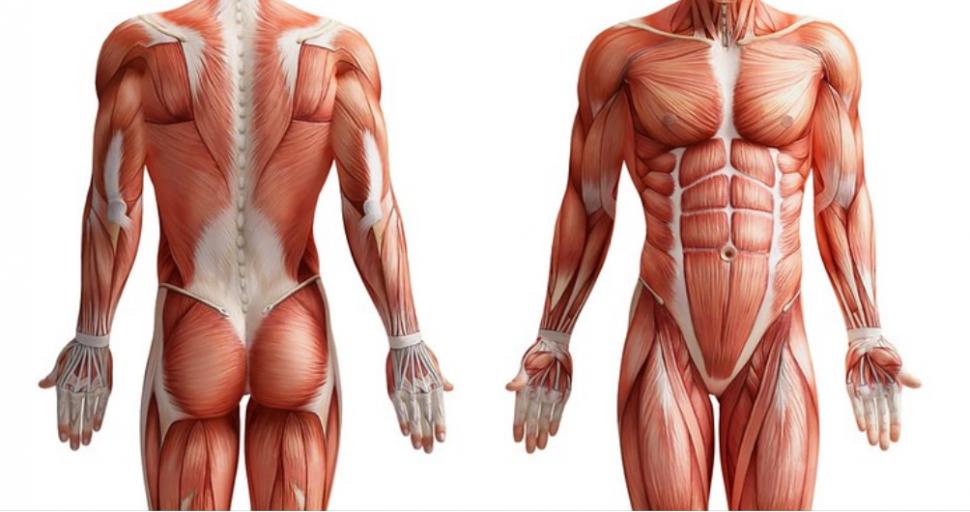- News
- Reviews
- Bikes
- Components
- Bar tape & grips
- Bottom brackets
- Brake & gear cables
- Brake & STI levers
- Brake pads & spares
- Brakes
- Cassettes & freewheels
- Chains
- Chainsets & chainrings
- Derailleurs - front
- Derailleurs - rear
- Forks
- Gear levers & shifters
- Groupsets
- Handlebars & extensions
- Headsets
- Hubs
- Inner tubes
- Pedals
- Quick releases & skewers
- Saddles
- Seatposts
- Stems
- Wheels
- Tyres
- Tubeless valves
- Accessories
- Accessories - misc
- Computer mounts
- Bags
- Bar ends
- Bike bags & cases
- Bottle cages
- Bottles
- Cameras
- Car racks
- Child seats
- Computers
- Glasses
- GPS units
- Helmets
- Lights - front
- Lights - rear
- Lights - sets
- Locks
- Mirrors
- Mudguards
- Racks
- Pumps & CO2 inflators
- Puncture kits
- Reflectives
- Smart watches
- Stands and racks
- Trailers
- Clothing
- Health, fitness and nutrition
- Tools and workshop
- Miscellaneous
- Buyers Guides
- Features
- Forum
- Recommends
- Podcast
feature
Strength training for cyclists: how to make your routine cycling-specific and build a rock solid core
Since the early 2000's, cyclists have started to understand the vital role that strength training plays in keeping us healthy, riding strong, and enjoying our time out on the bike more; but while many are now hitting the weights, they are often following bodybuilding programmes, not strength training programmes specifically for cycling.
If your 'strength training for cycling' routine simply mimics the movements we already do thousands of times in our wonderful sport, then it's time to change it. Before we delve into the exercises to build a rock solid core in part 1 of this series, let's look at the five reasons why this programme will give you actual results out on the road...
> Find our whole strength training for cyclists series here
This strength training programme is year-round
What if I told you that as a cyclist you should only be riding your bike from September until March, and after March you should stop riding your bike until your big event? In that time between March and your event, you should only ride the bike once or twice a week, only at an easy pace, to do your shopping.
I would hope that you'd tell me to get lost!
We all know that in that break away from riding you would lose all the fitness you had worked so hard to gain; yet this is exactly how riders treat their strength training, and it causes you to waste your time in the gym. That's time you can never get back.
A true strength training programme for cyclists should be year-round, which takes into account where you are in your riding season (whatever that may be), helping to keep your body in balance, and moving you forward in your abilities on the bike.
This programme has just as much upper body as lower body
The vast majority of strength programmes masquerading as 'cycling specific' simply load up your legs with squats, deadlifts, lunges, hamstring curls, and loads of planking. Yet these are often the last thing you need!
Strength training that helps boost performance, whether you’re a racer or not, focusses on balancing out the movements from our chosen sport, and work on the other parts of the body that allow us to perform and move better.
For cyclists this means the focus should be on:
- Rotary stability, to help us learn how to lock the rib cage and hips together to produce more power
- Improved breathing patterns and better posture, especially in the upper body, helps us to take in more air, and thus get more out of our engine
- Better shoulder and neck health, a common area of neglect for many cyclists, that should be included in any cycling programme
- Improve hip strength for glutes and inner thighs
The programme helps address common weaknesses cyclists have
As mentioned in point two, the programme should help us stay balanced, healthy and strong. This means it must include some kind of pulling, overhead pressing, and pushing (such as press-ups). Many cyclists cannot do a proper press-up, which is also an indicator of poor posture and poor breathing patterns on the bike; two major factors in sapping power, endurance and recovery.
These major multi-joint movements allow us to function better as human beings, and cyclists of all ages and abilities will get big returns on the bike when they're performed properly.
You won't get sore, or feel like rubbish after each workout
Ah, DOMS. Delayed Onset Muscle Soreness, AKA “my legs still hurt from my strength training session 3 days ago”, is a common phrase heard in cycling circles around the world; however, pushing ourselves in the gym to a 9 or 10/10 effort each session actually decreases the returns we will see from our efforts.
Strength training for performance, especially for a sport like cycling, is built around workouts that are medium to medium-hard; in other words, the workouts are 5’s, 6’s, and 7’s on a scale of 1-10. Pushing to your limits in the gym won't lead to improvement, it leads to more damage to the tissues and thus longer recovery times. This means you won't get what you need out of your on-bike training in order to see the results you want, because you’re too sore or tired.
A little soreness the next morning after a strength workout for an hour or so is ok, but soreness beyond that means you’ve pushed too hard.
There is a dynamic warm-up that helps you move and feel better
The first 10-15 minutes of each strength training session can offer you huge benefits, if you plan them correctly! While many think of warming up for strength training as simply doing 1-2 sets with little to no weight, we can, and should, be getting far more out of this time.
A properly designed dynamic warm-up will include 4-6 exercises that will help you prepare physically and mentally for that day’s session, as well as target 1-2 weaknesses you may have. The dynamic warm-up should include 1-2 sets of each exercise and have you moving swiftly through them, so that you break a light sweat towards the end. Done consistently 3-5 days a week, this dynamic warm-up is a keystone to unlocking strength, power and on-bike abilities you already possess, but have not yet tapped into.
How to build a rock solid core
If you’re like most people, you’ll think about the 'six-pack' as being the core. In fact, your 'core' includes all of the muscles between your neck, elbows, and knees, as well as the many joints in between. Understanding the true definition of core is extremely important, as it allows you to understand that how we actually produce power on the bike involves more than your stomach.
Teaching the body how to produce stiffness at the torso, hips, and spine, and allowing movement to happen more efficiently from the hips and shoulders, is at the core of training for performance. More technically, this could be described as 'producing proximal stiffness to produce distal motion'.
Learning how to do this is a skill that needs to be practised and refined, which takes time, consistency, and focused practice. It can't be sped through haphazardly just to 'get it done'. For those who put in the effort, the rewards are often huge.
Core training for performance routine
Taking your core training up a few levels to see real on-bike gains should not take hours on end, and certainly shouldn't get in the way of your riding. The following is a 15 minute core training for performance routine you can practice 3-4 days a week, with a day of rest in between sessions.
Your goal is to do each exercise correctly, each and every repetition. When you begin to lose technique, your set is done. It is NOT about “getting in” the sets and repetitions written. Follow what your body can do, and take your time to get it correct.
McGill Crunch
Also known as the McGill Curl-up, this exercise will challenge you to fire up your entire 360 degree abdominal hoop, helping you to fire all the muscles of the midsection to lock together with the hips and the rib cage. Watch the video carefully, and follow the cues. It's a small movement, but taking the time to master this move will have huge positive benefits.
If you have high blood pressure, or have been told by your physician not to hold your breath and produce internal pressure, skip this exercise. Perform one set of three repetitions, holding each for five seconds. It doesn't matter which leg is straight and which is bent.
Side Plank Top Foot Forward
Many learn how to do the side plank with the feet together; but by splitting the feet, with the top foot forward, we’re able to strengthen more of the obliques (the muscles on your sides) as well as the inner thigh muscles. This is key to helping you keep your hips nice and steady so you can sprint, climb, or bomb down the road with power, instead of looking like a hula-hooper on the bike.
Make sure your elbow is directly under your shoulder. There shouldn't be any pain in your shoulder while doing this.
Straight Leg Kickback
Can you fire your glutes, while keeping your hamstrings turned off? Can you do that while keeping your ribs and hips locked together? The Straight Leg Kickback on all fours will challenge you to get movement from the hip, while keeping your torso stiff and rock solid. If this is too challenging for you, you can start simply by keeping the toes on the ground, and sliding the toes backwards on the floor, getting movement only from the glutes. It's simple, but definitely not easy!
Perform two sets of 3-5 repetitions on each side, finishing all sets on one leg, before taking a short break, resetting, and doing it the other side.
Front Plank Hand-to-Shoulder with Hold
The upper body plays a huge part of optimal power production, and your ability to ride for long periods of time. This often goes unchallenged in core routines, besides supporting your upper body.
This exercise will teaches you how to keep your shoulder blade stable on your ribs, while resisting gravity trying to force you to separate your ribs and hips. Pay attention as you perform these, as most cyclists let their quadriceps and hip flexors take over for their midsection. We want to keep a perfectly straight line from the ears, to the shoulders, to the hips, knees and ankles. Start off with your hands on something high enough that you struggle a little, but can still control and fire your midsection.
Start off with two sets of five, alternating hands. Take your time, lifting the hand slowly, and setting the hand back down slowly, with zero movement anywhere else in the body. When two sets of five at that height is easy, move your hands down 10-15cm lower.
Hip Lift March with Isometric Hold
The ability to have the muscles of the core (again, everything between the knees, elbows, and neck) be able to resist forces trying to separate the hips from the ribs in all positions is important. For cyclists, who get hundreds of hours a year in the prone (face down towards the ground) position on the bike, turning the other way is incredibly important, as it allows you to fire muscles in ways they are not used in your sport.
The Hip Lift March with Isometric Hold will expose many weaknesses, as well as whether you truly have a bulletproof core. Start with three sets of three repetitions each side, holding for three seconds, alternating sides.
This exercise will prove very difficult for the vast majority of cyclists to do correctly. If you cannot lift your foot off the ground without your hips tilting to one side or the other, start by simply unweighting your heel of one foot off the floor, leaving the toes lightly touching the floor.
3-1-3-1 Tempo Goblet Squat
You can squat, right? While many think they can, their core (everything between the knees, elbows, and neck) are not working well together! The 3-1-3-1 Tempo Goblet Squat slows you down, helping to expose weaknesses and reveal whether you’re performing your squat correctly or not.
Aim to feel your entire body working in harmony to maintain control and perfect technique through the entire movement. Glutes fire for the one second pause at the bottom, and through the three seconds to stand back up. The one second at the top is not a rest, but is a decrease in tension before starting the next repetition. Start with two sets of 5-8 repetitions holding a 4-8kg kettlebell.
Conclusion
Understanding 'the core' is far more than just your belly, and learning how to create enough stiffness throughout the body to get movement from the hips and shoulders, it unlocks power you are already capable of producing, and can be a complete game changer for many cyclists. But it isn’t easy! Take the time to master each of these exercises, keeping in mind that more is NOT always better. Take your time to perform each repetition of each set with great technique, with the correct muscles working, and you’ll reap big rewards out on the bike, and in your daily life.
In part 2/5 of our strength training series, we'll be looking at how to use strength training to improve your climbing power with another set of essential exercises for you to master. Continue to parts 2 and beyond here.
Buy The Vortex Method: The New Rules For Ultimate Strength & Performance in Cycling here
Visit the Human Vortex Training website here
Disclaimer: We strongly recommend that you consult with your doctor before beginning any exercise programme. You should be in good physical condition and be able to participate in the exercise. road.cc is not a licensed medical care provider and represents that it has no expertise in diagnosing, examining, or treating medical conditions of any kind, or in determining the effect of any specific exercise on any medical condition. You should understand that when participating in any exercise programme, there is the possibility of physical injury. If you engage in any part of this exercise programme, you agree that you do so at your own risk, are voluntarily participating in these activities, assume all risk of injury to yourself, and agree to release and discharge road.cc from any and all claims or causes of action, known or unknown.
Menachem Brodie is a leading strength coach for cyclists and triathletes. He is the author of The Vortex Method: The New Rules for Ultimate Strength & Performance in Cycling, and the Strength Training for Cyclists Certification. He works with cyclists and triathletes from around the world to improve their performances through strength training designed to meet their sport's needs.
Latest Comments
- Disgusted of Tunbridge Wells 1 hour 9 min ago
Erm... You forgot to mention The Tyne Tunnel opened in 1951!!!...
- mark1a 1 hour 26 min ago
A very sad story and why, regardless of what the Highway Code says, never use a standard horn in close proximity to other road users. ...
- Destroyer666 1 hour 41 min ago
Always? So the guy is asked to appear on a podcast to discuss performance enhancing drugs and answers questions posed to him, which go beyond what...
- David9694 2 hours 51 sec ago
"Babergh District Council said it had been "clear throughout" that it "had no option but to introduce charges" and could not afford to continue to...
- Pub bike 2 hours 37 min ago
Maybe it is the latest ruse for insurers to avoid payouts saying "You didn't tell us that you took the key out of the lock so we're refusing your...
- KDee 5 hours 56 min ago
I'm still running an ELMNT BOLT V1, and I've never really understood the LED's. I'm sure I configured them for HR zones, but never really look at...
- don simon fbpe 7 hours 22 min ago
Why is this not the will of god?
- hawkinspeter 10 hours 25 min ago
PKD foresaw it, though his novel was based on a different outcome of WWII, not the precursor to WWIII. Maybe the Idiocracy film is a closer fit?
- OnYerBike 12 hours 27 min ago
@Sredlums: I'm not sure I follow your logic. If someone grabs your helmet twists it, then the reason it doesn't feel good is because the outer is...
- Rapha Nadal 12 hours 28 min ago
Coming to the mid-paced Saturday club ride soon.





Add new comment
2 comments
I applaud showing a core exercise routine being demonstrated by someone who doesnt own a huge space to do it in. Bravo for the real world experience many can relate to!
Thank you, Hope you find these challenging, and rewarding for your riding!